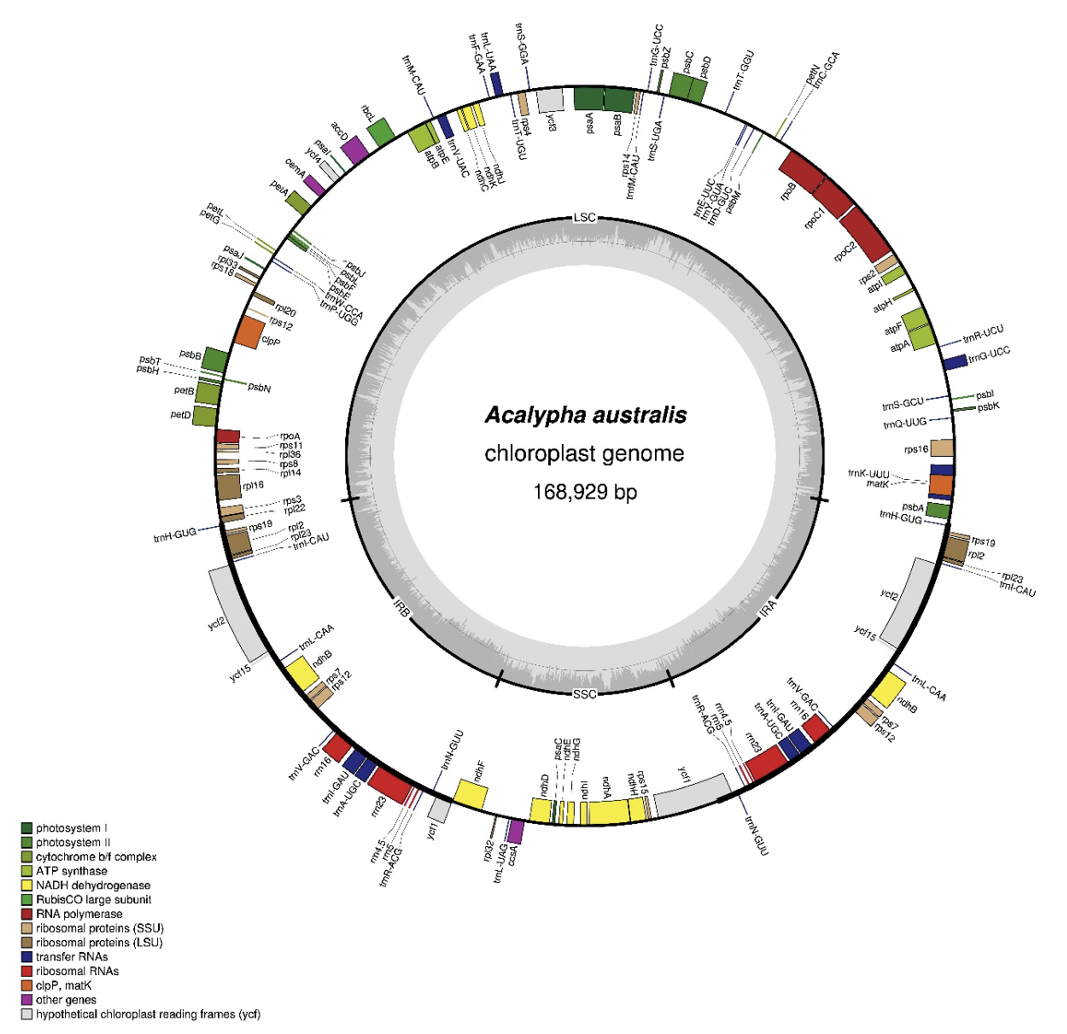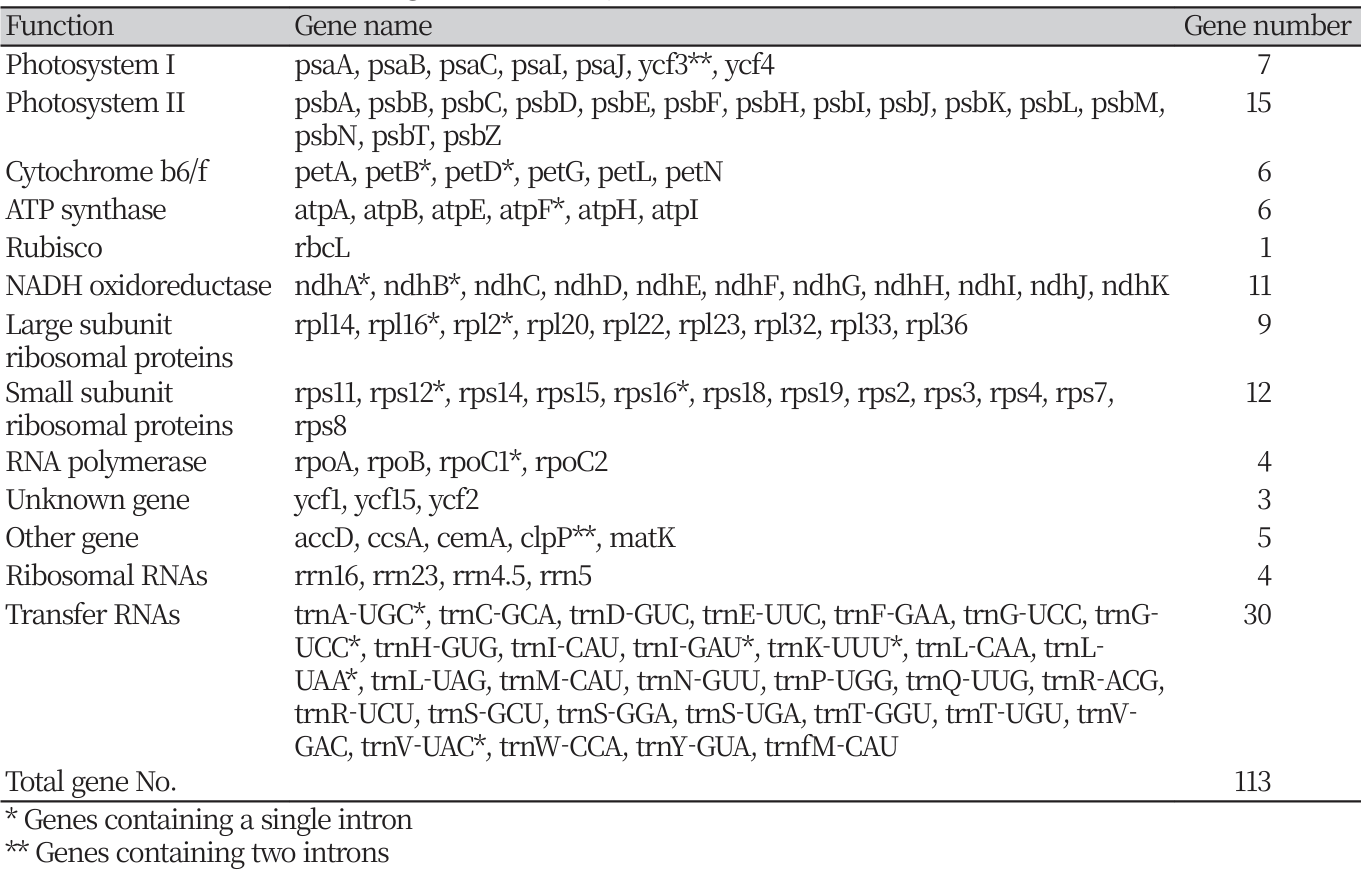깨풀(Acalypha australis L.)은 대극과 일년생 하계잡초이다. 최근 콩 등 일년생 밭작물 재배지나 사과, 배 등 과수원에서도 발생이 증가하고 있다. 종자는 휴면성이 있어 연속적 발아를 보이며(Han et al., 2000, Kang et al., 1993) 방제적기를 설정하기가 어려운 편이다. 광엽잡초에 선택성이 있는 벤타존으로 방제가 어려운 것으로 알려져 있으며(Kwon et al., 2004), 농업 현장에서는 주로 글리포세이트나 글루포시네이트와 같은 비선택성제초제를 사용하여 방제하고 있다. 깨풀의 엽록체 유전체 및 벤타존 등 제초제와 관련한 유전자의 염기서열을 분석하여 제초제 내성의 원인을 밝히고자 하였다.
깨풀의 엽록체 유전체(chloroplast genome)의 염기서열을 분석하기 위해 깨풀이 우점하고 있는 경북의 안동시 사과 과수원(36° 27′ 29.80″N, 128° 54′ 02.10″E)에서 5지점을 무작위로 선정하였고, 표토(0-5 cm)를 채집하였다. 채집한 토양을 모두 섞어서 혼합한 후 3 cm 두께로 토양을 전개하였다. 전개 21일 후, 완전전개엽을 채집하여 액체질소와 함께 막자사발에서 곱게 갈았으며, DNeasy® Plant Mini Kit (QIAGEN, Hilden, Germany)를 이용하여 제공되는 방법에 따라 DNA를 추출하였다.
염기서열은 Illumina MiSeq platform (Illumina Inc., CA, USA)을 사용하여 분석하였으며, de novo assembly는 CLC Assembly Cell package ver. 4.2.1 (QIAGEN, Hilden, Germany)를 사용하였다. 유전체 지도는 Kim et al. (2015)이 제시한 de novo assembly of low coverage whole genome shotgun sequencing (dnaLCW) 방법으로 완성하였다. 상동성은 Mega BLAST Search 결과를 비교 및 분석하였다(Schwartz et al., 2003).
완성된 깨풀의 엽록체 유전체의 길이는 168,929 bp 로 분석되었고, Aligned read는 962,802개였으며, Coverage는 784.61이었다(Table 1). dnaLCW 방법으로 깨풀의 엽록체 유전체를 assembly한 결과, large single copy (LSC)가 94,317 bp, inverted repeat A (IRA)가 27,448 bp, small single copy (SSC) 19,716 bp, inverted repeat B (IRB) 27,448 bp였다(Table 1). 깨풀의 엽록체 염기서열과 근연종의 엽록체 유전체를 비교한 결과, 가장 상동성(homology)이 높은 종은 같은 대극과의 관목류인 Mallotus paniculatus로 82%였다.
깨풀의 엽록체 유전체는 총 113개의 유전자로 구성되어 있었다(Table 2). Protein-coding genes (PCGs)는 79개였고, transfer RNA (tRNA)는 30개였으며, ribosomal RNA (rRNA)는 4개였다. 이 중, 18개의 유전자(rps7, rps12, ndhB, rpl2, rpl23, rrn4.5, rrn5, rrn16, rrn23, ycf2, ycf15, trnA-UGC, trnI-GAU, trnL-CAA, trnM-CAU, trnN-GUU, trnR-ACG, trnV-GAC)가 2 copy 이상 존재하고 있었다. 인트론(Intron)이 하나인 유전자는 16개였으며, 2개인 유전자도 2개가 있었다.
엽록체 유전자 중 psbA는 PSII 저해제와 관련이 있다. 깨풀은 PSⅡ 저해제(D1 Histidine 215 binders) 벤타존으로 방제가 어려운 것으로 알려져 있으며(Kwon et al., 2004), D1 protein을 저해하는 신규물질인 tenuazonic acid에 대해서도 높은 내성을 보였다(Zhou et al., 2019). 또한, 온실 조건에서도 깨풀에 대한 벤타존의 방제가가 매우 낮은 것을 확인하였다(data not shown). Pedroso et al. (2016)은 D1 protein을 코딩하는 psbA 유전자의 변이로 인해 PSII 저해제에 저항성이 나타날 수 있다고 보고하였다. psbA 유전자의 변이(Val219 to Ile)로 알려진 PSII 저해제 저항성 및 감수성 psbA 유전자와 본 연구에서 분석된 깨풀의 psbA 유전자의 염기서열을 비교한 결과, 깨풀의 psbA 유전자에 변이는 없었다. 따라서, 깨풀에 대한 벤타존의 약효 저하 현상은 psbA 유전자에 기인한 것은 아니며, 대사작용과 같은 다른 원인일 것으로 판단되었다.
본 연구에서는 대극과 일년생 잡초 깨풀의 엽록체 유전체를 분석하여 완성하였고, PSII 저해 제초제 저항성 혹은 내성과 관련한 유전자 염기서열 분석하였다. 이를 바탕으로 깨풀 방제 및 저항성 기작구명 등으로 연구 범위가 확장되어야 할 것으로 판단된다.
요약
깨풀은 대극과 일년생 여름잡초이며, 최근 발생면적이 크게 증가하고 있다. 벤타존에 내성이 있는 것으로 알려져 있지만, 그 기작은 알려진 바가 없다. 본 연구에서는 깨풀의 엽록체 유전체 및 벤타존 등 제초제와 관련한 유전자의 염기서열을 분석하여 제초제 내성의 원인을 밝히고자 하였다. 경북 지역의 사과 과수원에서 채집한 토양을 전개하고, 발아한 깨풀의 잎을 채집하여 DNA를 추출하였다. De novo assembly of low coverage whole genome shotgun sequencing 방법으로 엽록체 유전체 지도를 완성하였다. 완성된 깨풀의 엽록체 유전체의 길이는 168,929 bp 로 분석되었다. Large single copy (LSC)가 94,317 bp, inverted repeat A (IRA)가 27,448 bp, small single copy (SSC) 19,716 bp, inverted repeat B (IRB) 27,448 bp였다. 깨풀의 엽록체 유전체는 총 113개의 유전자로 구성되어 있었다. D1 protein을 코딩하는 psbA 유전자의 변이로 인해 PSII 저해제에 저항성이 나타날 수 있지만, 깨풀의 psbA 유전자에 변이는 없었다. 따라서, 깨풀에 대한 벤타존의 약효 저하 현상은 psbA 유전자에 기인한 것은 아니며, 대사작용과 같은 다른 원인일 것으로 판단되었다.
Acknowledgments
This work was carried out with the support of "Cooperative Research Program for Agriculture Science and Technology Development (Project No. PJ01500303)" Rural Development Administration, Republic of Korea. This study was supported by 2023 the RDA Fellowship Program of National Institute of Agricultural Sciences, Rural Development Administration, Republic of Korea.





